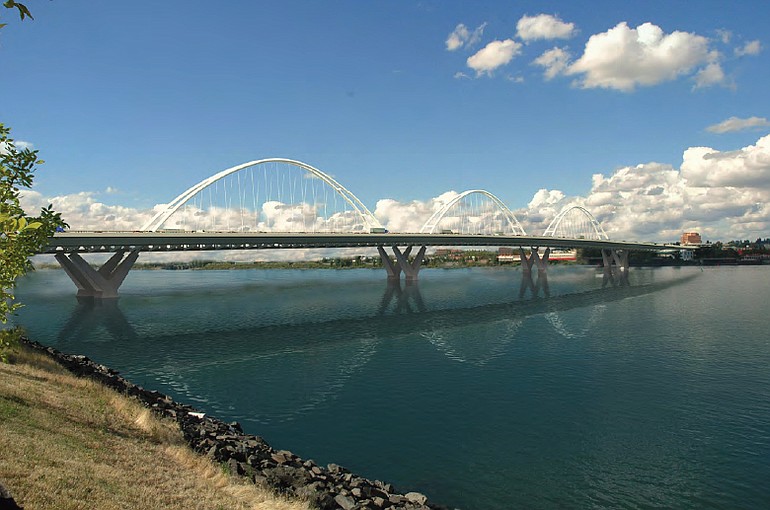Currently estimated to cost $3.6 billion, the entire Columbia River Crossing project would replace the two existing three-lane drawbridges across the river with 10 lanes, revamp seven interchanges along five miles of freeway, and extend Portland’s light-rail transit system into downtown Vancouver.
Project planners anticipate a three-way cost split among the federal government, the two states and local revenue generated by bridge tolls.
Click here to visit the Columbian’s I-5 Bridge page for project-related news and history.
Project planners scrambled Friday to assess a series of three alternatives for a new Interstate 5 bridge, a day after a review panel recommended killing the heavily criticized previous design.
Currently estimated to cost $3.6 billion, the entire Columbia River Crossing project would replace the two existing three-lane drawbridges across the river with 10 lanes, revamp seven interchanges along five miles of freeway, and extend Portland's light-rail transit system into downtown Vancouver.
Project planners anticipate a three-way cost split among the federal government, the two states and local revenue generated by bridge tolls.
Govs. Chris Gregoire and John Kitzhaber gave their two state transportation departments until the week of Feb. 21 to recommend one of three alternatives proposed Thursday by a 16-member Bridge Expert Review Panel.
Yet the new alternatives present issues of their own.
The panel chaired by Utah transportation expert Tom Warne offered a choice of tied-arch, cable-stayed and composite deck truss designs. The panel found that each design would be cheaper and more durable than the CRC team’s open-web box girder design, largely because the panel straightened the bridge’s alignment.
The old CRC alignment envisioned the bridge bending in a broad arc downstream from the current I-5 bridge. Warne’s panel calculated that straightening the bridge— saving money on raw material and requiring fewer piers — would bring $10 million to $100 million in savings. However, a straight bridge across the river requires engineers to bend the freeway on land.
Don Wagner, the CRC’s Washington co-director, said that would mean one of two things in Vancouver: A hairpin turn not unlike I-5’s notorious Terwilliger curves in Portland, or bending the freeway even farther into downtown Vancouver — a scenario that would likely wipe out the 6-story West Coast Bank building.
“It seems pretty obvious at first glance that those would be the only two options we have,” Wagner said.
Friday Harbor-based bridge designer Kevin Peterson said a straight alignment makes sense, as it’s one he’s proposed since last year. However, he’s exasperated by the panel’s decision to place the bridge downstream rather than upstream of the current span.
“Why would you want to do that when you can just go straight?” he said.
Peterson’s proposal has met with resistance from project officials worried about moving the span closer to the Fort Vancouver National Site.
Stephen Horenstein, a Vancouver attorney who co-chairs the bistate Project Sponsors Council for the CRC project, actually works in the West Coast Bank building and represents the owner.
Yet he does not support Peterson’s idea.
“I am strongly opposed to something on the east side of the (existing) bridge,” Horenstein said. “First of all, it’s not the right thing to do. And second of all, the mitigation there would be very costly.”
But Peterson contends that the footprint won’t intrude any farther into the fort than the old CRC plan.
That’s mainly because his plan does away with the wide cloverleaf-style interchange between the freeway and downtown. Instead, Peterson envisions motorists entering and exiting the bridge on a lower deck carrying slower shore-to-shore traffic between closely spaced interchanges at Highway 14, Hayden Island and Marine Drive in Portland.
An upper deck would carry traffic past the area at faster freeway speeds.
The Bridge Expert Review Panel rejected this idea as “fundamentally incompatible with the unusual interchange density for an interstate as proposed by the project today.”
Erik Robinson: 360-735-4551, or erik.robinson@columbian.com.



